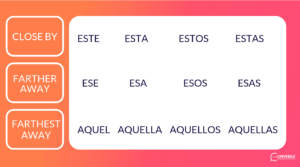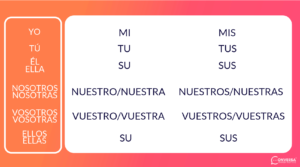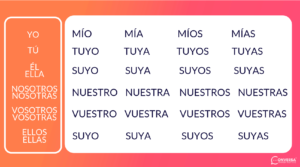- [email protected]
- +34 961258767
- Av. del Marqués de Sotelo 3, Planta 2, Puerta 4, 46002 Valencia
Centro Acreditado por el Instituto Cervantes
Centro Acreditado por el Instituto Cervantes

Are you learning Spanish and find yourself struggling with grammar? We don’t blame you. Although Spanish doesn’t have a very complex grammar, it’s generally trickier than English grammar. That’s why we want you to forget all your Spanish-related troubles and keep a positive attitude while reading our blogs! Let’s learn Spanish demonstrative and possessive adjectives and enjoy a free online activity below!
Don’t know what they are? That’s okay, you don’t need to become a linguist. Adjetivos demostrativos son básicamente las palabras que utilizas para expresan la proximidad de la cosa estamos hablando de en relación con el orador. En inglés: esto, eso, estos, aquellos. En español, funcionan exactamente igual, salvo que hay tres grados de proximidad:

Como puedes ver, en español tendremos que prestar atención a la género y número del sustantivo del que estamos hablando. Dicho de otro modo:
Además, estos adjetivos no sólo pueden expresar proximidad espacial, sino también proximidad temporal:
Del mismo modo, tenemos los adjetivos posesivos. Su funcionalidad es la misma que la del demostrativo pero, como su nombre indica, en lugar de expresar proximidad muestran posesión en relación con el hablante.
Y así sucesivamente.
Now to the tricky part of today’s grammar lesson. The possessive adjectives take two kinds of forms:

Bear in mind that in Spanish, the adjective will change both depending on the speaker AND on the object/person we’re referring to. So let’s check the table below:

In English, when we say “this cat of mine”, we don’t know the gender of the cat. But in Spanish we would be specific, and the possessive adjective will have to match the gender:
Como de costumbre, al español le gusta especificar sexo y número all the time. It’s not the most practical, but it’s not too hard to learn. In this case, -o para hombre, -a para mujer –s para plural. Tan sencillo como eso. Así que no te sientas intimidado por las distintas formas. Como siempre decimos, esto se irá incorporando a tu vocabulario de forma natural con el tiempo y la práctica.
And don’t forget to check out this free online activity below… Click on the lightbulb on the left upper corner to get the English translation of each sentence. It’s a hard one this time!
| Galleta | Duración | Descripción |
|---|---|---|
| cookielawinfo-checkbox-analytics | 11 meses | Esta cookie es establecida por el plugin GDPR Cookie Consent. La cookie se utiliza para almacenar el consentimiento del usuario para las cookies de la categoría "Analytics". |
| cookielawinfo-checkbox-functional | 11 meses | La cookie se establece por el consentimiento de cookies GDPR para registrar el consentimiento del usuario para las cookies en la categoría "Funcional". |
| cookielawinfo-checkbox-necessary | 11 meses | Esta cookie es establecida por el plugin GDPR Cookie Consent. Las cookies se utilizan para almacenar el consentimiento del usuario para las cookies en la categoría "Necesario". |
| cookielawinfo-checkbox-others | 11 meses | Esta cookie es establecida por el plugin GDPR Cookie Consent. La cookie se utiliza para almacenar el consentimiento del usuario para las cookies de la categoría "Otros". |
| cookielawinfo-checkbox-performance | 11 meses | Esta cookie es establecida por el plugin GDPR Cookie Consent. La cookie se utiliza para almacenar el consentimiento del usuario para las cookies de la categoría "Rendimiento". |
| viewed_cookie_policy | 11 meses | La cookie es establecida por el plugin GDPR Cookie Consent y se utiliza para almacenar si el usuario ha consentido o no el uso de cookies. No almacena ningún dato personal. |
Rellena el siguiente formulario y nuestro equipo de admisiones se pondrá en contacto contigo en un plazo de 24 a 48 horas.